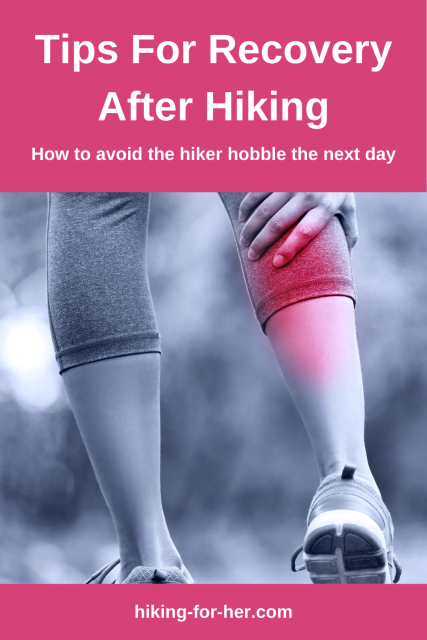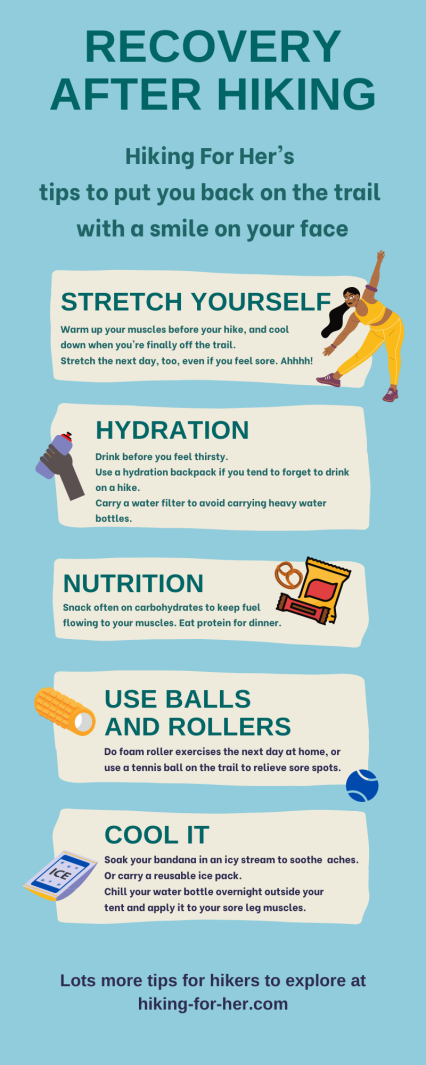
Recovery After Hiking:
Tips For Dealing With
Post Hike Fatigue And Soreness
By Diane Spicer
Recovery after hiking is an important topic for new hikers as well as veteran backpackers.
As a dayhiker, you have the luxury of being able to limp around for a few days at home/work/school after a vigorous hike, until your muscles stop screaming.
No such luxury when you're on a multiday backpacking trip. You've got to cover the miles, regardless of how you feel.
Of course, you could plan a trip with multiple "bail out" points. That means you call someone to get you, and you get off the trail.
But what's the fun in that? You want to complete your trip, right?
So recovery tips for soreness and fatigue apply to all types of hiking.
How to shorten your recovery time
after a hike
Let's make a list!
Skip down to the stuff that sounds best for you in this post hike recovery list:
To use this stash of 11 tips to shorten recovery after hiking to its fullest, experiment with each item during/after your upcoming day hikes this season.
Take note of how you feel the next day, and the day after that (which may be when you feel most sore, due to delayed onset muscle soreness, or DOMS).
Some things will work better than others for you. Stick with them!
Note on motivation to use this list
Pay attention to the suggestions on the list that are an immediate turn off.
- You'll hear your inner voice say, "Nah, that's too (easy/hard/silly/etc.)".
Revisit those with an open mind.
I don't make suggestions that don't work, so it's on this Recovery After Hiking list for good reasons.
Just sayin'!
Now let's get started down the road to suggestions for shorter post hike recovery times.
Stretch before and after a hike
That means devoting at least 15 minutes to each, and getting really serious about lengthening those muscles.
Warm up, cool down, and feel the difference the next day. It's 30 minutes well invested in your hiking health.
Extra motivation:
- You see professional athletes stretch before and after an event, so because you're an endurance athlete, just do it!
And here's where you can test your internal fortitude:
- Can you force yourself to stretch or do a few passive yoga poses when you're still in the thick of post-hike soreness on Day 2?
Again, just do it, and take note of how you feel 15 minutes later. You're welcome ;)
Not sure where to begin?
Get started with these stretching tips for hikers.
Pay attention to your hydration status
for faster recovery after hiking
Water keeps your cells going, including your hard working muscles that will be very stiff and sore tomorrow if they are deprived of water.
- Drink more than you think you "want", because your cells need it.
- Drink before you have a conscious need to gulp down water.
- Investigate a hydration backpack, making it easier to keep your hydration status strong.
That means carrying more water on a hike, or carrying the technology to clean up the surface water you encounter.
So this is not an easy step to implement. But it's worth it!
You can geek out on hydration here.
Chill out whenever possible
Stash a reusable gel ice pack in your backpack, like this one.
Carry these "instant" cold packs you can use on demand.
Make use of your bandana plus snow fields or icy cold streams to craft a cold pack to cool down your hot spots in a flash: feet, ankles, knees, neck.
Use overnight cool/cold temperatures by leaving your full water bottle outside your sleeping area, and roll it over your achy muscles in the morning.
Or leave a wet towel or shirt out overnight, and wrap your sore legs in it.
- Chilly ways to start the day, but hey, it gets you back on the trail!
Roll with it, Part Two
Check out foam rollers if you want to dig into those sore spots. This is a great "day after a hike" approach when you have the luxury of time and space at home.
Here are some foam roller exercises for hikers that are easy and fun when accompanied by your favorite music. Blast it as loud as you can to drown out your groans (JK).
Tennis (ball), anyone?
Bring one on your hike, or anything small, hard, lightweight and round.
Use it to put pressure on your sore spots.
Example:
- If your left shoulder blade aches, lie down with the ball placed beneath the sore spot. Let your body weight gradually press out the soreness.
- This works best if you're well hydrated and are able to relax into the soreness.
You can also use the tennis ball to roll out tension and soreness in your feet, especially the arches and ankles.
- More tips for sore feet here
Vitamin I
As in ibuprofen, or other pain relief methods that are okay for you to use based on your unique medical history and personal preferences.
You're only masking the pain, so pair this with other tips on this list.
Also, be careful when you've taken pain relief.
- Don't overdo things.
- Don't push yourself to resume your normal routine.
- Don't forget that while you might feel great (or at least better) right now, your sore muscles are still working things through. Drink water, eat well, rest.
More tips for you:
- Anti inflammatory tips for hikers here
- Here's an anti inflammatory tea I use.
Natural topical products for hikers
There are CBD, arnica, and other formulations that work for some people to minimize soreness after a hike.
Rub them on during and after your hike, but be aware that odors in bear country are to be avoided.
Here's an odorless arnica formulation that I've had good luck with.
- More tips for dealing with sore muscles here.
Eat like a smart hiker
for faster recovery after hiking
You want to eat a good ratio of carbohydrates, proteins and fats so your muscles can recover every day.
But the trick is getting your ratios right for your activity level, gender and age.
A few general ideas:
- Plenty of carbohydrates will fuel your
muscles during your hike.
- A post hike dinner with lots of protein will help your muscles recover, so choose fish, poultry, or legumes as the centerpiece.
- Dayhikers need a good selection of trail food, which you can explore here.
- If backpacking food is a mystery to you, get started here to learn how to plan great menus that will support your body in its hard work.
- Keep the trail snacks flowing! But choose the good ones that not only taste great, but support your body.
Brace yourself!
Sometimes your joints need some support.
Wear an athletic bandage or a brace on a joint that is prone to post hiking soreness, and see if you can minimize the impact.
Research how an ergonomic support can help you with your recovery time.
Trekking poles
Use them.
Why?
They take a load off your knees going downhill, give you more leverage going uphill, and improve your balance which in turn minimizes the strain on your neck, back and limbs.
And that's just for starters. Read more here.
If you're hiking with folks who think poles are (and I quote) "useless, expensive, a waste of money, or a marketing ploy", give yourself a chance to try them anyway! Your knees are your own business, right?
Electrolytes might make a difference
in your recovery after hiking
Add powdered electrolytes to your water bottle.
These deliver the nutrients your muscles need to keep going and avoid cramping.
They also give your water bottle an added incentive to keep you drinking: delicious flavors with no additives, fillers or sugars.
I use Ultima right now (lemon flavor), but Nuun is another brand I can recommend based on trail performance.
A shortcut to remind yourself to
make time for recovery after hiking
This hiking infographic will put you in a position of strength for your hiking season!
More ways to think about shortening
your recovery after hiking
You've found a lot of tips to try out by reading this far.
But think about hiking fundamentals as a core component in your recovery time as a hiker.
That's what this website is all about, sharing hiking fundamentals with you.
Dial in your hiking routine so your trail time is not only safer and more enjoyable, but most likely to leave you in decent shape to hike another day.
- Invest time to find a backpack that fits your particular contours.
- Wear footwear that minimizes leg fatigue and supports your load.
- Set a good pace and adjust it throughout the day as terrain and your energy levels change.
- Minimize your pack weight by choosing lightweight gear even for day hikes. Do this over several seasons of looking at end-of-season sales or discount on line stores like Backcountry, shop for REI bargains year round, and choosing innovative cottage brands from Garage Grown Gear.
- Slide into a hot bath after your hike filled with Epsom salts and soak for at least 30 minutes.
Recovery after hiking takes dedication
It's one thing to hobble around, groaning and moaning about how sore and stiff you feel after a hike, and never learn how to avoid the pain.
It's another thing entirely when you decide to take the situation firmly in hand with proactive and smart strategies to minimize the soreness after hiking.
You've just read a lot of ideas for how to do that.
Now the question is:
"How much do you value your hiking body?"
Hopefully, your answer leads to faster recovery after hiking! I'm betting on you, because you spent all this time reading these recovery tips :)
Need even more?
Here are healthy hiking tips that will get you in top shape to hit the trail, and enjoy your hikes even more.
May all your trails be happy and limp-less!
Home > Hiking Tips And Tricks >
Faster Recovery After Hiking
|
I get emails all the time about what I wear, eat, carry and love to use on the trail. That's
why I provide affiliate links to you: the best gear that I use myself and have seen used by other hikers is instantly
available for your consideration, and the gear company sends a few
pennies per dollar to this reader-supported hiking website. There is no added cost to you! Everyone ends up a winner: Great gear for you, strong gear companies, and more free hiking tips for everyone. Thanks very much for your support. It's warmly and sincerely appreciated. It also helps send these hiking tips to all your virtual trail buddies around the globe. |
 |



